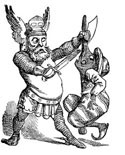
The Traditionalists’ Untraditional Ideas About Religious Freedom
ARE TRADITIONALISTS SURE OF THEIR TRADITION?
Does the Second Vatican Council’s teaching on religious liberty deviate from the authoritative traditional teaching of the Church? My article in the October 1998 NOR concluded that it does not. In an article in the July-August 1999 NOR, Jeffrey Lehmann responded that “conciliar teaching and traditional Catholic teaching seem to be in conflict,” and that “Tardiff’s article didn’t persuade” him otherwise. Lehmann’s critique is sober and courteous. But in considering the objections he raises, I find that it has become clearer than ever that there is no “conflict,” and that the decree of Vatican II on religious liberty titled Dignitatis humanae (DH) does fulfill its explicit intention of leaving “untouched traditional Catholic doctrine.”
My article claimed that in discussing “religious liberty” and the notion of a “right” to said liberty, it is essential to distinguish two very different kinds of rights. There are active rights (the right to do something) and there are passive rights (the right not to be prevented from doing something). I argued that DH concerns itself with the second category, with passive rights, whereas the Church prior to Vatican II, when teaching on religious freedom, had focused on the first category, active rights.
Lehmann does not dispute that the distinction between active and passive rights may be valid. But he objects that my illustrations of such rights apply only to the private sphere. He says that I failed to show that there is a difference between active and passive rights applicable to public actions (the issue at hand when we discuss religious practices). He also claims that magisterial teaching before Vatican II does in fact discuss and disallow the passive right to religious liberty that I discern in DH, and he cites papal and other documents to support his contention.
How to reply? I should note, first, that my article was heavily dependent upon — since it was a response to — the analysis done by Michael Davies in his book The Second Vatican Council and Religious Liberty. Davies, of course, is no apologist for the orthodoxy of Vatican II, and yet after years of study he concludes: “if the absence of a right to say what is false in public [active right] can be reconciled with a right not to be prevented from saying what is false [passive right], then the teaching of Dignitatis humanae can be reconciled with the traditional teaching” (emphasis added). Evidently Davies does not share Lehmann’s view that the traditional teaching clearly addresses, let alone condemns, the idea of a passive right to religious liberty.
You May Also Enjoy
The pains and sufferings of our walking pilgrimage will be offered as a penance for the special intention of the resurrection of the Tridentine Latin Mass.
One of the saddest features of contemporary Catholicism is the wide range of accusations hurled…
There are no protagonists in the latest liturgical drama, only antagonists. Nobody comes out clean, neither traditionalists nor Pope Francis.

